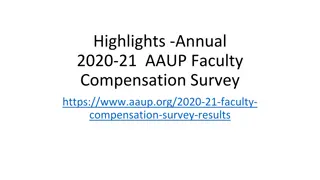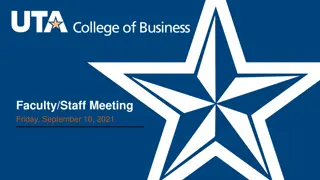Effective Faculty Assignment Strategies for Academic Departments
Importance of faculty assignments in maintaining department operations, facilitating change, and maximizing individual strengths. Discussion on assigning tasks based on historical practices, comparison of peers, and goal-setting at departmental level. Emphasis on typical areas assigned such as teaching, research, and service. Suggestions for establishing a department profile and enhancing teaching, research, and service elements for faculty.
Download Presentation

Please find below an Image/Link to download the presentation.
The content on the website is provided AS IS for your information and personal use only. It may not be sold, licensed, or shared on other websites without obtaining consent from the author.If you encounter any issues during the download, it is possible that the publisher has removed the file from their server.
You are allowed to download the files provided on this website for personal or commercial use, subject to the condition that they are used lawfully. All files are the property of their respective owners.
The content on the website is provided AS IS for your information and personal use only. It may not be sold, licensed, or shared on other websites without obtaining consent from the author.
E N D
Presentation Transcript
Some Approaches to Faculty Assignments Lawrence Abele, October 2018 1
Why Assignments are Important If the department is operating smoothly and meeting all goals, assignments will ensure that this continues. If the Chair and faculty believe change is necessary assignments are a critical element in effecting the change desired. 2
Assignments to Individuals Assignments may be made based on historical or past practice activities. AND/OR Assignments may be made based on a comparison of peers; it is possible to use the Delaware data set to establish teaching standards and other data sets to establish research standards. 3
Assignments at the Departmental Level In this model, the faculty and chair agree on the goals that they wish to accomplish in the academic year. Assignments may vary significantly among faculty as each individual s strengths are maximized. As with individual assignments, they can be based on historical practices or peer benchmarks. 4
Assignments to Effect Change Where is your department now? Where would you like it to be? Where do you obtain the information necessary to make assignments to effect change? 5
Typical Areas Assigned Teaching Teaching, including standard class lectures, seminars, supervision of interns, independent studies, honors thesis, graduate thesis, doctoral dissertation, and others. Research Research that may include funded programs, creative works and other scholarly activities with an explicit expectation that the results will be performed or published. Service Service generally refers to faculty governance, service to national organizations or to the state or community that is within the areas of expertise and non-compensated. 6
Establish an Accurate Profile of your Department What is your current teaching Quality and Quantity? What is your current research profile-Quality and Quantity? Are there service elements that you would like to enhance or promote, i.e., service on NSF, NIH or other panels, positions in national organizations? 7
Benchmarks for Departmental Goals Benchmarks for Departmental Goals Sources Criteria Delaware Study of Faculty Workload: http://www.udel.edu/IR/co st/ Objective Comparative NSF sites, especially Institutional Profiles Peer Institutions National Research Council: http://www.nap.edu/rdp/# download Web of Knowledge 8
This Site allows a Wide Variety of Comparisons https://ire.udel.edu/descriptive-summary/ 9
The Delaware Study Includes: Comparisons of Teaching quantity, cost and productivity. By type of institution. By degree granting status. By the criteria that you establish for comparisons. 10
Benchmark Examples (per term) Class Size Class Size UG SCH G SCH Chemistry Research Doctoral Comprehensive 1.0 1.7 2.7 276 263 261 92 51 32 0.5 0.6 0.4 34 22 7 22 12 6 Economics Research Doctoral Comprehensive 1.3 2.0 3.2 213 226 252 56 37 26 0.7 0.6 0.4 36 16 16 17 9 13 Humanities Research Doctoral Comprehensive 1.9 1.8 4.3 212 158 278 11 37 29 22 0.5 0.4 0.3 16 17 8 11 14 9
An Easy to Use Tool https://www.nap.edu/rdp/#download http://sites.nationalacademies.org/pga/resdoc/ 12
Ph.Ds.org Welcome to PhDs.org! Profiles of over 4900 doctoral programs across 59 fields to help you evaluate and decide on a school to attend. https://www.nap.edu/download/12994 This is the Excel file with the data. 13
The National Research Council s Study of Doctoral Programs Studies were done in 1982, 1993 (1995) and 2010. Data have been updated to April 29, 2011. Number of Institutions: 212. Number of Fields: 62 plus 10 emerging fields. Number of programs included >5,000. All data available at no cost in an Excel spreadsheet with video directions for analyses. Data posted on IAL website 14 http://www.phds.org/
Research Benchmarks Publications/ % Active Year/Fac PhD % Publishing Grants Students/Fac Chemistry Quartile I Quartile 2 Quartile 3 Quartile 4 88 85 81 77 3.10 2.38 1.61 1.26 73 57 45 33 5.29 3.34 2.77 2.13 Economics Quartile I Quartile 2 Quartile 3 Quartile 4 73 72 70 58 0.61 0.56 0.59 0.33 23 12 5 3 3.03 2.52 1.84 2.43 Humanities Quartile I Quartile 2 Quartile 3 Quartile 4 (Awards) 1.05 0.76 0.19 0.14 N/A N/A N/A N/A 2 0 0 0 1.01 1.37 1.71 1.98 15
Faculty Assignments Faculty Assignments Teaching Economics: (example, doctoral institution) On average, the department should offer per faculty member per term: 2.0 undergraduate courses and 0.6 graduate courses with average enrollments of 37 undergraduate and 9 graduate 16
Additional Teaching Assignments UG Honor Courses Other Other Issues NAME GLENN ANDERSON THOMAS BENNETT BARRY CLARK JOHN CARTER VIVIAN DELGADO GREGORY EDWARDS MICHAEL EUBANKS BRIAN GOODSON WILLIAM GOODY MALCOM HILL RICHARD JACKSON EDWARD JONES EUGENE JOHNSON ROBERT LAWSON RALPH NICHOLSON Assignments EXPECTED TOTAL 5 18
Research Benchmarks (Economics- Second Quartile) For faculty in this category, ~70% publish regularly, averaging ~ 0.5 papers per year in refereed journals. Only 12% have active grants which means that about 36% of the faculty should be submitting proposals each year. On average, each faculty member advises ~2.5 doctoral students. 19
Research Benchmarks Active Federal Grants Grant Refereed Publications NAME GLENN ANDERSON THOMAS BENNETT BARRY CLARK JOHN CARTER VIVIAN DELGADO GREGORY EDWARDS MICHAEL EUBANKS BRIAN GOODSON WILLIAM GOODY MALCOM HILL RICHARD JACKSON EDWARD JONES EUGENE JOHNSON ROBERT LAWSON RALPH NICHOLSON Submissions EXPECTED TOTAL 2 to 4 6 to 12 8 to 9 20
Advantages of this Approach The data are comparative and national. Most of the data are assembled by independent agencies. Most of the data are not self- reported. The evaluation and assignment involves all members of the unit. 21
Weaknesses It is often difficult to find comparative data for all disciplines. Humanities data are often insufficient or lacking. Data are skewed toward sciences and journal articles. 22























